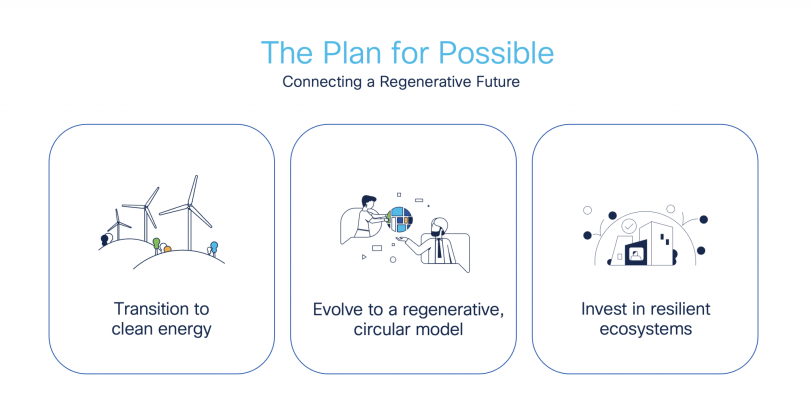“Regeneration means putting life at the center of every action and decision,” Paul Hawken wrote in his book Regeneration: Ending the Climate Crisis in One Generation. “Climate change may leave people feeling as if they have to make a choice between ‘saving the planet’ and their own happiness, well-being and prosperity. Not at all.”
In July, Cisco’s Chief Sustainability Officer, Mary de Wysocki, echoed many of Hawken’s sentiments as she laid out the company’s mission for building a regenerative future — one that is inclusive, resilient and possible to achieve.
“We can’t have any kind of future if we don’t have a healthy planet,” de Wysocki wrote. “Regeneration means moving beyond a ‘doing no harm’ mindset to one in which we build the capacity of our social and environmental systems to heal and thrive.”
“Regeneration means moving beyond a ‘doing no harm’ mindset to one in which we build the capacity of our social and environmental systems to heal and thrive.”
Understanding the interconnection of communities is key to building a regenerative future, according to both Hawken and de Wysocki. Neither individuals nor individual organizations can build a net-zero future or reverse a century of fossil fuel reliance alone, but Cisco is taking a holistic approach to environmental sustainability. This approach includes engaging with suppliers and helping customers and communities reduce their environmental impacts as they adapt to a changing world.
“The progress we make in this decade will be critical for future generations,” de Wysocki said. “By pursuing what’s possible, we can accelerate the transition into the digital age while maintaining the health of the planet — and a climate future we all need and desire.”

Cisco’s focus on emissions reductions is captured in its goal to reach net zero across its value chain by 2040. The goal has been approved by the Science Based Targets Initiative under its Net-Zero Standard, which is aligned with the need to limit global temperature rise to 1.5 degrees Cesius above preindustrial levels. Cisco was one of the first technology hardware and equipment companies to have its net-zero goal validated under the standard.
Built In spoke with three sustainability leaders at Cisco and Meraki, a Cisco business unit focused on building cloud-managed IT solutions, about how they are furthering this regenerative mission and the possibilities for advancing sustainability in every role across the organization.
“Building a sustainable future involves seeing and understanding the interconnectedness of society and the environment,” said Human Rights Program Manager Fischer Heimburger. “The current climate crisis is simultaneously an ecological and a socioeconomic crisis, and it disproportionately harms vulnerable and marginalized communities — the very communities least responsible for the crisis.”
“Building a sustainable future involves seeing and understanding the interconnectedness of society and the environment.”
Heimburger’s reflective and integrative perspective on the climate crisis is emblematic of the approach across Cisco, with its focus on inclusive policies that will enable an expansive and positive future for all.
“We are all working toward a common goal,” added Global Sustainability Lead Christian Zachriat. “Every business unit is contributing to that same journey.”
Zachriat is focused on initiatives that make Cisco’s products more sustainable and energy efficient across the supply chain, but he notes that delivering a product to the client isn’t where that sustainability focus ends.
“Our technology can also help customers make progress toward their own sustainability goals,” he said. “When we consider energy management capabilities and environmental sensors that give visibility into the efficiency of a building, we are seeing the dual approach of internally collaborating across teams to drive change and the external side of helping our customers become more sustainable. This transformation touches every business function.”
For Energy and Sustainability Manager Catherine Paquette, elevating sustainability as a core priority at Cisco has resulted in dramatic advancements both internally and externally. While Cisco’s teams had been setting and achieving goals in sustainability and reducing greenhouse gas emissions for over 15 years, expanding the scope of sustainability at Cisco to a unified companywide goal and customer priority has increased engagement and advancement across internal teams and with external partners.
“People have cared about sustainability for a long time, but previously, the focus was from a small group who knew what to look for,” Paquette said. “Now, everyone from customers to investors to competitors are looking at our programs and goals to understand our priorities and how they fit together. The scope of our sustainability programs extend far beyond our own operations as we work to reduce emissions across our value chain.”
Embedding Sustainability in Every Role
The shift to focus on sustainability across lines of business has meant that the work of sustainability professionals like Heimburger, Zachriat and Paquette is only one part of Cisco’s comprehensive approach to addressing the climate crisis.
“We need sustainability advocates with a wide range of backgrounds and skills,” Paquette said. “People can bring their expertise to a sustainability team, or they can bring their commitment to sustainability into their own team and help embed sustainability into their area of the business.”
Heimburger cited a quote he picked up at a conference focused on sustainability: “If we are to fight against the climate crisis, we need to think about every job as a sustainability job.”
“The crisis is multifaceted and doesn’t come with a single solution,” he said. “To start moving in the right direction, we need diverse people from diverse backgrounds working on diverse solutions. In every role, we have an opportunity to weave a sustainable narrative into our work.”
“In every role, we have an opportunity to weave a sustainable narrative into our work.”
Whether an engineer is designing solutions to reduce environmental impact or a salesperson is helping customers adopt more sustainable products, professionals across Cisco are working together to integrate sustainability into how it does business.
“It’s always possible to embed sustainability in what you already do right now. In the past, sustainability and business success were seen as separate, but now the realization is that these priorities support each other well,” Zachriat said. “That’s the beauty of working in sustainability — fulfilling the mission and amplifying success.”
ONE COMPANY, MANY CAREERS
Fischer Heimburger: “I studied sustainability and human rights at UC-Berkeley and knew that I wanted to focus my career on how institutions can drive meaningful, impactful change. I started with Cisco as a sustainability intern within Workplace Resources, where I was able to research corporate net-zero strategies. I then joined the FLEX program, which empowers those early in their careers to pursue impact-driven work and develop as leaders. This led me to work on Cisco’s enironmental, social and governance strategy and reporting team and, most recently, join our business and human rights team. I’m grateful to be part of a program which enables me to pursue my passions within the sustainability ecosystem as Cisco.”
Christian Zachriat: “I joined Cisco in 2020 as a technical solutions architect for the channel in the UK, and shortly after joining, I wanted to find out what we are doing in terms of sustainability. I basically got started on my journey with Cisco Meraki on sustainability through asking a lot of questions. I reached out to many people to identify existing initiatives and realized that there’s still an opportunity to get involved and drive this transformation. During this time, I obtained a Business Sustainability Management certification from Cambridge University. It was clear to my leaders that I wanted to devote my full-time role to sustainability. About a year ago, the business created a new role around sustainability. I applied and interviewed for it, was offered the position, and then moved into the role. With a background in technology, I can empathize with the typical challenges and priorities in IT while helping to create a bridge between technology and sustainability.”
Catherine Paquette: “I studied sustainability in my undergrad years as an architecture and environmental studies student, where I focused on the building-related aspects of sustainability. The summer before I graduated, I interned with the Global Energy Management and Sustainability team within Workplace Resources — Cisco’s internal real estate department. After I graduated, I returned to the team full-time and found my niche within environmental, social and governance reporting. Over the years, I’ve transitioned into managing reporting and communications related to our internal sustainability efforts.”

Pioneering Efforts
“It is a great moment in time to get involved in sustainability,” Zachriat said. “Some people might think they’re too late — but if you start today, you’re still a pioneer.”
Both Zachriat and Paquette point to the possibilities created by the “green skills gap.” According to recent reporting in the Wall Street Journal, despite a 20 percent increase in green jobs posted on LinkedIn in 2022, the increase in users reporting a “green skill” on their profiles was only just over 8 percent.
To address this gap, Cisco and other companies are supporting nontraditional career development for individuals like Zachriat, who pursued his career in sustainability after working as a solutions architect and in sales.
“There are so many different opportunities at Cisco to grow, and there is support from leadership to enable you to do that,” Paquette said. “Managers want to help employees grow and to feel connected to the overall mission, especially when it comes to sustainability. This is a perfect time for new folks to come in and be a champion for advancement.”
For Heimburger, this approach reflects the larger mission for achieving Cisco’s sustainability goals.
“You have to be willing to ask the hard questions, and even more so, be willing to hear the hard answers,” he said. “You have to be willing to communicate and humble yourself — the best solutions may come from unlikely places.”
He added, “The challenges we face today can’t be solved by a single person or a single company. They will be solved by passionate people sharing their voice, working together and never giving up. This is a culture of sustainability.”








